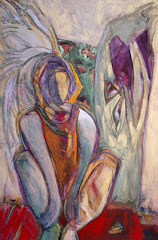Who is Thomas Kinkade? Artist or fraud? Through much reading, I have come to believe there is a great difference between the Thomas Kinkade of the past and the present. The young, inspirational, determined Kinkade of the past should be considered a genuine artist. He took his passion and distributed a book to help others achieve an understanding of his gift. He created original works of art and shared them with galleries throughout California. This allowed for admirers and artists alike to share his passion and talent. This young man, undoubtedly had a gift. However, as we all learn in life, temptations will arise. This is when we see what a person is made of and how strong their will for personal perseverance actually is. Does Kinkade remain true to his passion, or will he succumb to the pressures of profits and greed?
A true artist, I believe would have been more cautious with the idea of becoming a “sell-out,” as I believe the Kinkade of the present is. A true artist would not allow his passion to be replaced with a dollar sign. Kinkade has used his religious conviction to falsely portray his works as something more than they are. He uses Christianity as a way of gaining trust and credibility. He portrays his works and actions as a religious opportunity for investors and buyers. These current works of his really are more of the ideas he once values simply recreated by various means, excluding self creation. Yes, it’s true! He does not have any hands on influence in these works that are being massively distributed to millions of people. The Thomas Kinkade that we know today is a master of manipulation and profitability, rather than a master of art. He had allowed his skill and passion to take a back seat to the fast track to stardom. He seeks profit, rather than a true passion for the arts. This is quite evident by the fact that he stopped selling originals, to “punish” people for taking a disliking to the prints that he was streamlining to millions. When profits declined, he held the true art hostage as if to threaten buyers. This is not the ideals of a true artist and moreover the religious man he has so evidently portrayed himself to be.
The man who I have learned of has become a millionaire through fraud, manipulation, and the mass production of works that have a similar liking to those that he once created himself. By looking at his website, one might be swayed to believe him as a genuine artist who has reached financial success through exhibiting a true passion for the artistic ability that he was gifted with. However, it fails to mention the idea of prints, which is what his money-making scheme has been based upon. Yes, I believe to an extent, print making is a wonderful idea, since it allows for art to reach a wider audience. However, I feel as if Kinkade has tried to hide this major detail in the hopes of making more money. I feel that his passion for art has ceased and been replaced with a decision to become a businessman with a passion for greed.

Monday, March 31, 2008
Sunday, March 2, 2008
Analyze That!!
Irises in Monet's Garden by Claude Monet definitely caught my attention. The use of expressive lines gives the image a loose, free feeling which is very realistic to the natural environment being portrayed. The lack of outlines and contour lines allows for this idea that the objects are freely moving, implying a sense of vulnerability to the wind or breeze the may arise on any given day. In this painting, Monet uses many different tints and shades of secondary colors. The cool colors used to depict the irises are very soothing to the eye and make the garden appear quite inviting. Monet uses a warmer color to depict the path through the garden which appears to lead to a vanishing point on the right side of the image. Atmospheric perspective is represented in the image where the image becomes blurrier or less distinct as it approaches the vanishing point. The hues are much cooler in this area compared to the darker shades of flowers at the point in which the path is first shown at the lower left corner of the painting. This area appears to have much more distinct contrasts between light and dark as compared to the area surrounding the vanishing point along the path. The overall lighting gives the appearance of the sun approaching the horizon, since the overall coloring is a warmer hue, rather than a washed out white that would appear if the sun was high above the horizon or a shadow-less image that would appear if the sun had already set below the horizon. A sense of texture is evident in Monet’s brushstrokes since the different hues are freely arranged and overlap throughout the painting. This arrangement of the irises also gives them a sense of motion, just as if they were freely blowing in the wind. All in all, Monet created a visually appealing masterpiece through the careful use of many of the concepts we have learned over the course of the semester. In my eyes, the most appealing factors were the use of motion, light and color which brought this image to life.
Subscribe to:
Comments (Atom)















